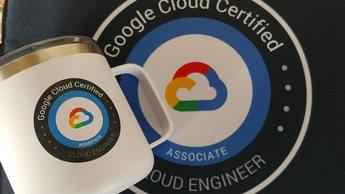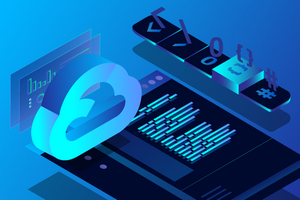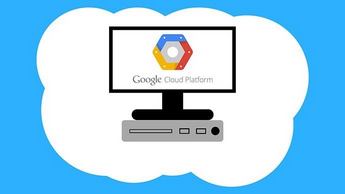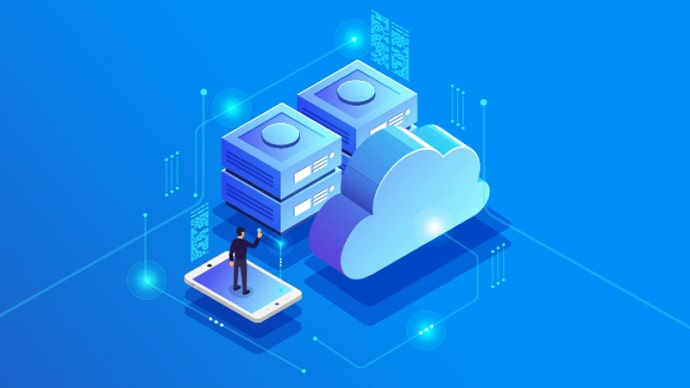
Cloud Digital Leader: Cloud Digital Leader
PDFs and exam guides are not so efficient, right? Prepare for your Google examination with our training course. The Cloud Digital Leader course contains a complete batch of videos that will provide you with profound and thorough knowledge related to Google certification exam. Pass the Google Cloud Digital Leader test with flying colors.

Curriculum for Cloud Digital Leader Certification Video Course
| Name of Video | Time |
|---|---|
 1. Introduction - Google Cloud Platform - GCP - Cloud Digital Leader Certification |
2:04 |
 2. Introduction to Cloud and GCP - Google Cloud Platform |
5:48 |
 3. Creating GCP - Google Cloud Platform - Account V2 |
2:18 |
| Name of Video | Time |
|---|---|
 1. Step 01 - Why do we need Regions and Zones |
2:31 |
 2. Step 02 - Understanding Regions and Zones in GCP - Google Cloud Platform |
3:54 |
| Name of Video | Time |
|---|---|
 1. Step 01 - Getting started with Google Compute Engine - GCE |
2:52 |
 2. Step 02 - Creating your first Virtual Machine in GCP |
7:54 |
 3. Step 03 - Installing HTTP Webserver on Google Compute Engine Virtual Machine |
6:43 |
 4. Step 04 - Exploring Compute Engine VM IP Addresses in Google Cloud Platform |
5:57 |
 5. Step 05 - Simplifying Web Server setup with Compute Engine Startup Script |
3:56 |
 6. Step 06 - Simplifying VM creation in Google Cloud Platform - Instance Templates |
4:59 |
 7. Step 07 - Reducing Launch Time with a Custom Image |
9:19 |
 8. Step 08 - Understanding Sustained Use Discounts in GCP - Google Cloud Platform |
2:36 |
 9. Step 09 - Understanding Committed Use Discounts in GCP - Google Cloud Platform |
1:50 |
 10. Step 10 - Saving Costs with Preemptible VMs |
3:20 |
 11. COURSE UPDATE - Quick Review of Spot VMs |
1:40 |
 12. Step 11 - Creating VMs on Dedicated Host with Sole Tenant Nodes |
7:43 |
 13. Step 12 - Understanding Custom Machine Types |
2:07 |
 14. Step 12a - Exploring Licensing Costs for Google Compute Engine |
2:31 |
 15. Step 13 - Quick Review - Google Compute Engine |
2:11 |
 16. Step 14 - Managing multiple VMs using Instance Groups in GCP |
6:00 |
 17. Step 15 - Creating Managed Instances Groups in Google Cloud V2 |
11:21 |
 18. Step 16 - Playing with Managed Instances Groups in Google Cloud |
4:04 |
 19. Step 17 - 0 - Load Balancing in Google Cloud Platform - Cloud Load Balancing |
1:38 |
 20. Step 17 - Creating a Load Balancer in Google Cloud with Cloud Load Balancing V2 |
8:52 |
 21. Step 18 - Exploring Load Balancer in GCP - Google Cloud Platform |
3:16 |
| Name of Video | Time |
|---|---|
 1. Step 01 - What are Managed Services? |
1:07 |
 2. Step 02 - Understanding IAAS and PAAS |
5:06 |
 3. Step 03 - Understanding Evolution to Containers and Container Orchestration |
7:48 |
 4. Step 04 - Understanding Serverless |
2:22 |
 5. Step 05 - Understanding SaaS (Software as a Service) |
2:00 |
 6. Step 06 - Understanding Shared Responsibility Model |
3:33 |
 7. Step 07 - Exploring Google Cloud Platform GCP Compute Services |
3:49 |
| Name of Video | Time |
|---|---|
 1. Step 01 - Getting Started with Google App Engine (GAE) |
3:48 |
 2. Step 02 - Understanding App Engine Environments - Standard and Flexible |
2:55 |
 3. Step 03 - Playing with App Engine - GAE |
13:53 |
 4. Step 04 - Exploring App Engine in GCP - App, Services and Versions |
6:53 |
 5. Step 04a - IaaS or PaaS or SaaS - Service Categories - Scenarios |
3:25 |
 6. Step 05 - Getting Started with Google Kubernetes Engine GKE |
3:08 |
 7. Step 06 - Kubernetes Journey - Creating a GKE Cluster |
4:33 |
 8. Step 07 - Kubernetes Journey - Create a Deployment and a Service |
8:23 |
 9. Step 08 - Kubernetes Journey - Scaling Deployments and Resizing Node Pools |
7:13 |
 10. Step 09 - Kubernetes Journey - Autoscaling |
4:00 |
 11. Step 10 - Delete GKE Service, Deployment and Cluster |
2:37 |
 12. Step 11 - Getting Started with Google Cloud Functions V2 |
2:00 |
 13. Step 12 - Creating your first Google Cloud - Cloud Function V2 |
8:13 |
 14. Step 13 - Getting Started with Google Cloud Run and Anthos V2 |
9:43 |
 15. Step 14 - Scenarios - GCP Compute Services |
2:11 |
| Name of Video | Time |
|---|---|
 1. Step 01 - Exploring Block and File Storage in GCP V2 |
8:27 |
 2. Step 02 - Playing with Object Storage in GCP - Cloud Storage |
5:48 |
 3. Step 03 - Exploring Cloud Storage in GCP |
3:25 |
 4. Step 04 - Understanding Cloud Storage - Storage Classes |
5:07 |
 5. Step 05 - Understanding Cloud Storage - Lifecycle Management |
3:18 |
 6. Step 06 - Transferring data to cloud - Online, Transfer Service and Transfer |
7:37 |
| Name of Video | Time |
|---|---|
 1. Step 01 - Understanding Database Fundamentals - Choosing Databases |
4:23 |
 2. Step 02 - OLTP Relational Databases in Google Cloud - Cloud SQL & Cloud Spanner |
2:28 |
 3. Step 03 - Demo - Playing with Cloud SQL |
5:48 |
 4. Step 04 - Demo - Playing with Cloud SQL - 2 |
6:05 |
 5. Step 05 - Demo - Playing with Cloud Spanner V2 |
8:21 |
 6. Step 06 - OLAP Relational Database in Google Cloud - BigQuery |
3:35 |
 7. Step 07 - NoSQL Databases in Google Cloud - Firestore, Datastore and BigTable |
3:50 |
 8. Step 08 - Demo - Playing with Firestore |
10:44 |
 9. Step 09 - In memory Database in Google Cloud - Memorystore |
1:01 |
 10. Step 10 - Databases in Google Cloud Platform - A Quick Review |
2:22 |
 11. Step 11 - Databases in Google Cloud Platform - Scenarios |
2:20 |
| Name of Video | Time |
|---|---|
 1. Step 01 - Getting started with Cloud IAM |
2:49 |
 2. Step 02 - Exploring Cloud IAM with an Example |
3:39 |
 3. Step 03 - Exploring Cloud IAM - Roles |
3:16 |
 4. Step 04 - Demo - Playing with IAM V2 |
3:12 |
 5. Step 05 - Getting Started with Service Accounts |
6:13 |
 6. Step 06 - Demo - Playing with Service Accounts |
7:09 |
| Name of Video | Time |
|---|---|
 1. Step 01 - Organizing Google Cloud Resources - Projects, Folders and Organization |
3:32 |
 2. Step 02 - Exploring Billing Accounts |
4:08 |
 3. Step 03 - Understanding IAM Best Practices |
3:20 |
 4. Step 04 - Cloud Computing Terminology - Public vs Private vs Hybrid Cloud |
4:56 |
 5. Step 05 - Implementing Hybrid Cloud with Cloud VPN and Cloud Interconnect |
3:20 |
 6. Step 06 - Understanding User Identity Management in GCP |
6:36 |
 7. Step 07 - Understanding Organization Policy Service |
3:15 |
 8. Step 08 - Exploring IAM Policy at multiple levels - Resourcing Hierarchy |
1:16 |
 9. Step 09 - Quick Introduction to Identity Platform - S9L10 |
4:40 |
| Name of Video | Time |
|---|---|
 1. Step 01 - Going Baremetal in Google Cloud |
2:33 |
 2. Step 02 - Getting Started with Google Cloud VMware Engine |
2:44 |
 3. Step 03 - Getting Started with Migrate for Compute Engine |
3:06 |
 4. Step 04 - Migrate for Anthos and GKE - S10L4 |
2:24 |
| Name of Video | Time |
|---|---|
 1. Step 01 - What is DevOps? |
2:28 |
 2. Step 02 - Exploring DevOps Practices - Continuous Integration, Deployment, ... |
5:06 |
 3. Step 03 - DevOps in Google Cloud - Continuous Integration, Deployment & Delivery |
2:03 |
 4. Step 03a - Exploring a DevOps Example - Cloud Run with Cloud Build |
2:05 |
 5. Step 04 - Exploring DevOps Practices - Infrastructure as Code |
3:36 |
 6. Step 05 - Exploring DevOps - Operations in Google Cloud |
3:44 |
 7. Step 05a - Exploring Cloud Operations Scenarios with Microservices |
1:56 |
 8. Step 06 - Getting Started with Site Reliability Engineering (SRE) |
3:39 |
 9. Step 07 - Understanding Key Metrics for Site Reliability Engineering (SRE) |
4:47 |
 10. Step 08 - Understanding Best Practices for Site Reliability Engineering (SRE) |
7:35 |
| Name of Video | Time |
|---|---|
 1. Step 01 - Understanding Need for Asynchronous Communication |
2:38 |
 2. Step 02 - Getting Started with Cloud Pub Sub |
4:14 |
 3. Step 03 - Exploring Cloud Pub Sub - Publishing and Consuming a Message |
2:21 |
 4. Step 04 - Demo - Playing with Cloud Pub Sub V2 |
10:14 |
 5. Step 05 - Getting Started with Cloud Dataflow |
4:41 |
| Name of Video | Time |
|---|---|
 1. Step 01 - Architecture - Loose Coupling with Pub Sub |
1:34 |
 2. Step 01a - Getting Started with Cloud Dataproc |
2:56 |
 3. Step 02 - Architecture 1 - Big Data Flow - Batch Ingest |
2:09 |
 4. Step 03 - Architecture 2 - Streaming Data |
1:18 |
 5. Step 04 - Architecture 3 - IOT |
1:46 |
 6. Step 04 02 - Architecture 4 - Data Lakes |
3:50 |
 7. Step 05 - Exploring API management - Apigee, Endpoints, API Gateway |
3:25 |
 8. Step 06 00 - Introduction to Artificial Intelligence & Machine Learning |
3:58 |
 9. Step 06 - Machine Learning - 10,000 Feet Overview |
2:54 |
 10. Step 07 - ML in Google Cloud - Pre Trained Models |
2:51 |
 11. Step 08 - ML in Google Cloud - Custom Models |
4:56 |
 12. Step 09 - Faster ML in Google Cloud - TPUs |
1:29 |
 13. Step 10 - Exploring Machine Learning - Data is the Key |
2:17 |
 14. Step 10 00 - Most important AI considerations - Responsible AI Principles |
5:35 |
 15. Step 10 - Machine Learning Scenarios |
1:15 |
 16. Step 11 - Getting Started with Firebase |
2:00 |
 17. Step 12 - Exploring Container Registry and Artifact Registry |
6:05 |
 18. Step 13 - Monolith to Microservices - Application Modernization |
2:19 |
 19. Step 14 - Important Security Related Services in Google Cloud |
8:12 |
 20. Step 15 - Understanding Zero Trust Security Model |
4:12 |
| Name of Video | Time |
|---|---|
 1. Step 01 - Understanding Cloud Native Architectures |
7:04 |
 2. Step 02 - Exploring Google Cloud Compute Services For Running Containers |
1:57 |
 3. Step 03 - Exploring Important Serverless Services in Google Cloud |
4:07 |
 4. Step 03 - Exploring Different Data Formats & Corresponding Google Cloud Services |
4:09 |
 5. Step 04 - Choosing Regions and Zones - Exploring Factors to Consider |
3:26 |
| Name of Video | Time |
|---|---|
 1. Step 00 - Section Introduction - Digital Transformation with Cloud |
0:31 |
 2. Step 01 - Introduction to Digital Transformation |
4:41 |
 3. Step 02 - Cloud is an Enabler for Digital Transformation |
4:30 |
 4. Step 03 - Google Cloud Adoption Framework - 10,000 Feet Overview |
4:16 |
 5. Step 04 - Infrastructure Modernization with Google Cloud |
2:01 |
 6. Step 05 - Application Modernization with Google Cloud |
2:35 |
 7. Step 06 - Business Platform Modernization with Google Cloud |
1:30 |
| Name of Video | Time |
|---|---|
 1. Step 01 - Total Cost of Ownership (TCO) |
2:00 |
 2. Step 02 - Consumption based vs Fixed price Pricing Models |
1:43 |
 3. Step 03 - Expenditure Models/ CapEx vs OpEx |
1:25 |
 4. Step 04 - How is Cost Decided? |
3:37 |
 5. Step 04a - Exploring Google Cloud Pricing Calculator |
7:37 |
 6. Step 05 - GCP Cost Management |
9:08 |
 7. Step 06 - Managing Costs - Best Practices |
2:11 |
| Name of Video | Time |
|---|---|
 1. Step 01 - Review - Basic Compute Services in Google Cloud |
1:57 |
 2. Step 02 - Review - Managed Compute Services in Google Cloud |
2:16 |
 3. Step 03 - Review - Storage Services in Google Cloud |
1:02 |
 4. Step 04 - Review - Databases in Google Cloud |
2:45 |
 5. Step 05 - Review - Streams, Analytics, Big Data Services in Google Cloud |
1:55 |
 6. Step 06 - Review - Migration to Google Cloud - Google Cloud Services |
1:10 |
| Name of Video | Time |
|---|---|
 1. Step 01 - Get Ready - Google Cloud - Cloud Digital Leader Certification |
2:19 |
 2. Step 02 - My Recommendations - Google Cloud - Cloud Digital Leader Certification |
1:32 |
Google Cloud Digital Leader Exam Dumps, Practice Test Questions
100% Latest & Updated Google Cloud Digital Leader Practice Test Questions, Exam Dumps & Verified Answers!
30 Days Free Updates, Instant Download!
Cloud Digital Leader Premium Bundle

- Premium File: 289 Questions & Answers. Last update: Dec 6, 2025
- Training Course: 146 Video Lectures
- Study Guide: 380 Pages
- Latest Questions
- 100% Accurate Answers
- Fast Exam Updates
Google Cloud Digital Leader Training Course
Want verified and proven knowledge for Cloud Digital Leader? Believe it's easy when you have ExamSnap's Cloud Digital Leader certification video training course by your side which along with our Google Cloud Digital Leader Exam Dumps & Practice Test questions provide a complete solution to pass your exam Read More.
Master GCP from Scratch and Become a Google Cloud Digital Leader
Google Cloud for Beginners: Kickstart Your Cloud Computing Journey with GCP and Become a Digital Cloud Leader
Course Overview
This course is designed to guide beginners through the essential concepts and practical applications of cloud computing using Google Cloud Platform. It provides a comprehensive introduction for those seeking to become proficient in managing cloud services and aspire to a digital leadership role in their organizations. Through this course, learners will gain a deep understanding of the core components of Google Cloud, including virtual machines, storage, data analysis, and serverless computing, as well as how to apply these tools to solve real-world business challenges.
The course structure emphasizes hands-on learning, ensuring participants not only understand theoretical concepts but also acquire practical skills that can be immediately applied. By engaging with interactive labs, exercises, and real-life use cases, learners will develop the confidence to navigate cloud environments effectively and make strategic decisions that enhance organizational efficiency.
This beginner-friendly training also introduces learners to the broader landscape of cloud computing, including its benefits, types of cloud models, and why Google Cloud Platform is a preferred choice for enterprises looking to optimize operations, scale services, and leverage advanced analytics. Participants will understand how cloud adoption can accelerate digital transformation initiatives, improve cost efficiency, and enable businesses to remain competitive in a rapidly evolving technology environment.
What You Will Learn From This Course
By the end of this course, learners will have a solid foundation in Google Cloud Platform and cloud computing principles. The following key skills and knowledge areas will be covered:
Understanding the fundamentals of cloud computing, including public, private, and hybrid cloud models.
Gaining familiarity with the Google Cloud console and navigating its interface.
Learning how to deploy and manage virtual machines using Compute Engine.
Understanding cloud storage options, data management, and security features.
Analyzing large datasets with BigQuery and performing efficient queries.
Exploring serverless computing through Cloud Functions and App Engine.
Implementing identity and access management to maintain security compliance.
Learning cost management strategies and utilizing pricing tools for budget optimization.
Understanding GCP regions, zones, and projects to organize resources effectively.
Developing practical skills through hands-on labs and exercises to reinforce theoretical knowledge.
Preparing for the Google Cloud Digital Leader certification by acquiring the required competencies and insights.
These learning outcomes are designed to provide a balance between technical understanding and strategic thinking, empowering learners to make informed decisions in their roles as cloud professionals or aspiring digital leaders. The course is structured in a way that gradually builds knowledge, starting from foundational concepts and moving toward practical, real-world applications of GCP services.
Learning Objectives
The learning objectives of this course are carefully structured to ensure that participants achieve measurable outcomes that enhance their cloud computing expertise. Upon completing this course, learners will be able to:
Define cloud computing and articulate its advantages for businesses.
Identify the various types of cloud deployment models and their practical use cases.
Navigate the Google Cloud Platform interface and understand the core services offered.
Create and manage virtual machines, including configuring compute resources and scaling infrastructure.
Implement cloud storage solutions for secure and efficient data management.
Analyze data effectively using BigQuery and generate actionable insights for decision-making.
Apply serverless computing concepts through Cloud Functions and App Engine.
Manage user roles, permissions, and access controls to maintain security and compliance.
Optimize cloud spending using GCP billing tools and cost management practices.
Recognize the strategic role of a Google Cloud Digital Leader in guiding cloud adoption and digital transformation.
Apply hands-on skills through lab exercises, demonstrating proficiency in core GCP services.
These objectives are aligned with industry requirements and certification standards, ensuring that learners not only gain theoretical knowledge but also develop practical skills that are highly valued in modern IT and business environments. The course emphasizes the integration of technical capabilities with strategic decision-making, which is essential for digital leadership in the cloud era.
Requirements
To enroll in this course, participants do not need extensive technical experience, making it suitable for beginners. However, a few basic requirements will help learners maximize their success:
Access to a computer with internet connectivity to use cloud services and participate in online labs.
A Google account to access Google Cloud Platform resources and services.
Basic understanding of computer operations, including using web browsers and installing software.
Willingness to engage in hands-on exercises and interactive learning activities.
Curiosity and a proactive mindset to explore cloud technologies and their applications in real-world scenarios.
While prior experience with cloud computing is not required, familiarity with fundamental IT concepts such as networking, storage, or data management can be helpful but is not mandatory. The course is designed to gradually build skills, so even those without a technical background can follow along and acquire the necessary competencies to succeed as a Google Cloud Digital Leader.
Course Description
This course provides a comprehensive introduction to Google Cloud Platform, equipping learners with the knowledge and practical skills needed to navigate cloud environments confidently. Starting with the basics of cloud computing, the curriculum covers the essential services offered by GCP, including Compute Engine, Cloud Storage, BigQuery, Cloud Functions, and App Engine.
Participants will explore the core concepts of virtual machines, scalable storage, serverless computing, and data analytics while gaining practical experience through interactive labs and exercises. The course emphasizes real-world applications, demonstrating how cloud technologies can be leveraged to solve business challenges, optimize processes, and drive innovation.
Learners will also develop a strong understanding of security, compliance, and cost management on Google Cloud. Topics such as identity and access management, data encryption, compliance certifications, and billing strategies are integrated into the curriculum, ensuring that participants can manage cloud resources efficiently and securely.
The course is designed to prepare learners for the Google Cloud Digital Leader certification by covering the skills and knowledge required to lead cloud initiatives within organizations. Beyond technical expertise, the course emphasizes strategic thinking, decision-making, and the ability to drive digital transformation, helping learners become effective digital leaders in a cloud-first world.
By the end of the course, participants will be confident in navigating the Google Cloud Platform, implementing core services, managing cloud resources securely, and making informed decisions that enhance organizational performance and innovation.
Target Audience
This course is ideal for a wide range of learners who are interested in building a career in cloud computing or enhancing their digital leadership skills. The target audience includes:
IT professionals seeking foundational knowledge in Google Cloud Platform.
Business managers and decision-makers looking to understand cloud solutions and their strategic benefits.
Students and recent graduates aiming to start a career in cloud technology or data analytics.
Professionals preparing for the Google Cloud Digital Leader certification.
Individuals interested in digital transformation and cloud adoption within organizations.
Technical professionals who want to expand their skillset to include cloud services and data management solutions.
The course content is tailored to ensure that even those without prior technical experience can gain a solid understanding of cloud computing concepts and practical skills. By targeting a diverse audience, the course ensures relevance for both technical and non-technical professionals who want to leverage Google Cloud Platform to drive innovation and efficiency in their organizations.
Prerequisites
This course is designed for beginners, so the prerequisites are minimal. However, certain basic skills will help learners follow the material more effectively:
Familiarity with using a computer and web browser.
A Google account to access cloud resources.
Basic understanding of general IT concepts such as networking, storage, and software applications.
Willingness to participate in hands-on exercises and interactive labs.
Openness to learning new concepts and technologies related to cloud computing.
No prior experience with Google Cloud Platform, programming, or data analytics is required. The course is structured to provide step-by-step guidance, gradually building learners’ knowledge and confidence. By completing the course, participants will acquire both theoretical understanding and practical skills necessary to manage cloud resources and lead digital initiatives within organizations.
The curriculum ensures that learners with minimal technical background can achieve a strong foundation in cloud computing and Google Cloud Platform. Practical labs, exercises, and examples reinforce concepts and provide real-world context, enabling learners to develop competencies that are immediately applicable in professional settings.
Course Modules/Sections
This course is organized into several modules, each focusing on key aspects of Google Cloud Platform and cloud computing for beginners. Each section is designed to build on the previous one, allowing learners to gradually develop both theoretical understanding and practical skills. The modules are structured to ensure that participants can follow along at their own pace while gaining hands-on experience with cloud resources.
The first module introduces learners to the fundamental principles of cloud computing, explaining the differences between public, private, and hybrid cloud models. Learners will explore the advantages of cloud adoption for businesses, including scalability, cost efficiency, and improved operational resilience. The module also highlights the reasons why Google Cloud Platform has become a preferred choice for many enterprises worldwide.
The second module delves into core Google Cloud services, starting with Compute Engine. Participants will learn how to launch, configure, and manage virtual machines to create scalable and reliable infrastructure. The module also covers the basics of Cloud Storage, providing learners with practical experience in storing, retrieving, and securing data in the cloud.
The third module focuses on data analytics through BigQuery. Learners will understand how to store large datasets, perform queries efficiently, and extract meaningful insights for decision-making. The module also introduces serverless computing with Cloud Functions and App Engine, allowing participants to explore event-driven applications and scalable services without managing infrastructure.
The fourth module addresses security and compliance. Participants will learn about identity and access management, encryption, and best practices to maintain secure cloud environments. This module also covers compliance standards relevant to organizations, ensuring learners understand regulatory requirements and industry benchmarks.
The final module emphasizes cost management and optimization. Participants will explore billing tools, pricing calculators, and strategies to control cloud expenditure while maximizing the value of cloud resources. This section provides actionable guidance on resource allocation, monitoring usage, and planning budgets effectively.
Each module is supplemented with interactive labs, exercises, and case studies, enabling learners to apply knowledge in practical scenarios. This approach ensures that participants gain both confidence and competence in managing cloud resources, preparing them for real-world applications and professional certification.
Key Topics Covered
The course covers a wide range of topics essential for beginners seeking proficiency in Google Cloud Platform. These topics include fundamental concepts, technical skills, and strategic knowledge required for digital leadership in cloud computing.
Introduction to cloud computing and understanding its core benefits for organizations.
Overview of cloud deployment models: public, private, and hybrid clouds.
Navigating the Google Cloud console and familiarizing with its user interface.
Core services offered by Google Cloud Platform, including Compute Engine, Cloud Storage, BigQuery, Cloud Functions, and App Engine.
Deploying and managing virtual machines, configuring instances, and scaling resources efficiently.
Implementing cloud storage solutions for secure, durable, and accessible data management.
Performing data analysis using BigQuery, executing SQL queries, and generating insights from large datasets.
Exploring serverless computing concepts and building applications using Cloud Functions and App Engine.
Understanding identity and access management to control user permissions and maintain security.
Implementing encryption strategies for data at rest and in transit, adhering to compliance requirements.
Cost management and optimization strategies to monitor usage, forecast expenses, and control budgets.
Organizing cloud resources using regions, zones, and projects for better governance and operational efficiency.
Real-world applications and case studies demonstrating how businesses leverage Google Cloud Platform to innovate, scale operations, and optimize processes.
The comprehensive coverage ensures that learners acquire both technical and strategic skills. The curriculum emphasizes practical applications, making it possible for participants to implement solutions that address organizational challenges and support digital transformation initiatives.
Teaching Methodology
The teaching methodology of this course is designed to provide a balance between theoretical knowledge and practical experience, ensuring that learners develop a strong foundation in cloud computing and Google Cloud Platform. The approach integrates multiple instructional strategies to engage participants effectively and facilitate deep learning.
The course begins with conceptual lessons that explain the fundamentals of cloud computing, the structure of Google Cloud Platform, and the advantages of adopting cloud services in business contexts. These lessons use real-world examples and case studies to illustrate concepts and provide context for learners.
Hands-on exercises and interactive labs are a core component of the teaching methodology. Participants are guided through practical tasks such as launching virtual machines on Compute Engine, configuring storage buckets in Cloud Storage, running queries in BigQuery, and deploying serverless functions. These exercises reinforce theoretical knowledge and allow learners to gain experience in navigating cloud tools, configuring resources, and troubleshooting common issues.
The course also incorporates visual demonstrations and tutorials, helping learners understand complex processes such as network configuration, data migration, and security implementation. These demonstrations provide step-by-step instructions while encouraging learners to experiment and explore on their own.
Collaborative learning is encouraged through discussion forums and group exercises, where participants can share insights, ask questions, and solve problems collectively. This interaction fosters peer-to-peer learning and helps learners gain multiple perspectives on using cloud technologies effectively.
Continuous assessment and feedback are integrated into the methodology to ensure learners are progressing and understanding key concepts. Quizzes, assignments, and scenario-based exercises allow participants to apply their knowledge in practical situations, receive feedback, and identify areas for improvement.
The teaching methodology emphasizes a structured progression from basic to advanced topics, ensuring that learners build confidence and competence in cloud computing. By combining lectures, practical exercises, visual demonstrations, and collaborative activities, the course ensures a comprehensive learning experience that prepares participants for professional roles in cloud technology and digital leadership.
Assessment & Evaluation
Assessment and evaluation are key components of this course, providing learners with opportunities to demonstrate their understanding and apply their knowledge in practical scenarios. The evaluation strategy is designed to measure both theoretical comprehension and hands-on proficiency in Google Cloud Platform services.
Quizzes and knowledge checks are integrated throughout the course modules to assess participants’ understanding of key concepts. These assessments focus on cloud computing fundamentals, core services such as Compute Engine and Cloud Storage, data analysis with BigQuery, and serverless computing with Cloud Functions. Knowledge checks help learners reinforce learning, identify gaps, and ensure retention of critical information.
Assignments and practical exercises allow participants to apply theoretical knowledge in real-world contexts. Tasks such as deploying virtual machines, configuring storage solutions, performing data queries, and implementing security measures enable learners to demonstrate competence in managing cloud resources. These assignments are evaluated based on accuracy, efficiency, and adherence to best practices.
Case studies and scenario-based assessments are included to evaluate participants’ ability to make strategic decisions using Google Cloud Platform. Learners analyze business challenges, propose solutions using cloud services, and justify their decisions based on technical feasibility, cost implications, and organizational objectives. These assessments develop problem-solving skills and encourage learners to think like digital leaders.
Interactive labs provide hands-on evaluation opportunities. Participants complete guided exercises in a cloud environment, simulating real-world scenarios. Lab performance is assessed based on task completion, correct configuration of resources, and effective use of Google Cloud tools. This practical evaluation ensures that learners acquire skills that are directly applicable in professional settings.
Final assessments consolidate learning across modules and provide a comprehensive evaluation of participants’ readiness to use Google Cloud Platform effectively. These assessments may include a combination of multiple-choice questions, practical exercises, and project-based tasks that require learners to integrate multiple services and demonstrate overall proficiency.
Continuous feedback is provided throughout the course to guide learners and enhance their understanding. Instructors and mentors review assignments, provide constructive comments, and offer guidance on improving technical skills and strategic thinking. This iterative feedback loop ensures that participants progress confidently and develop the competencies required to lead cloud initiatives successfully.
By combining quizzes, practical exercises, scenario-based assessments, labs, and continuous feedback, the course ensures a thorough evaluation of participants’ knowledge and skills. This approach not only prepares learners for real-world application of Google Cloud services but also equips them with the confidence and expertise necessary to pursue professional certification and excel as digital leaders in cloud computing.
Benefits of the Course
This course provides significant benefits for learners seeking to gain expertise in cloud computing and Google Cloud Platform. One of the primary advantages is the development of practical skills that are immediately applicable in real-world business environments. Participants learn how to deploy virtual machines, manage storage solutions, perform data analytics, and implement serverless applications, which can be applied to optimize workflows, improve efficiency, and support organizational objectives.
Another key benefit is the preparation for professional growth and career advancement. The course equips learners with the knowledge and skills necessary to pursue the Google Cloud Digital Leader certification. This certification demonstrates competence in cloud computing and positions participants as capable leaders in digital transformation initiatives. Employers increasingly value professionals who can navigate cloud platforms effectively and leverage technology to drive innovation and operational excellence.
The course also emphasizes strategic thinking and decision-making in cloud adoption. Learners gain insights into resource planning, cost optimization, and compliance management, allowing them to make informed decisions that balance technical requirements with business objectives. Understanding how to implement security policies, control access, and adhere to compliance standards ensures that participants can manage cloud environments responsibly and mitigate risks associated with data breaches or regulatory violations.
Hands-on learning is another significant benefit. The course includes interactive labs, exercises, and scenario-based tasks that simulate real-world challenges. These experiences help participants gain confidence in using cloud tools, troubleshooting issues, and applying best practices. By combining theory with practical application, learners develop the expertise required to manage cloud services efficiently and effectively.
Furthermore, the course fosters a mindset of continuous learning and adaptability. Cloud computing is a rapidly evolving field, and the ability to stay up to date with emerging technologies, tools, and best practices is critical. By engaging with the course content, participants develop the skills to adapt to changes, innovate solutions, and lead initiatives that harness the full potential of Google Cloud services.
Overall, the course provides a comprehensive foundation in cloud computing, technical proficiency in Google Cloud Platform, and strategic insight into digital leadership. These benefits collectively empower learners to drive cloud adoption, optimize resources, and lead digital transformation efforts in organizations of all sizes and industries.
Course Duration
The duration of this course is designed to balance comprehensive coverage of Google Cloud Platform services with flexibility for learners’ schedules. The total course is structured to be completed over several weeks, allowing participants to progress at a pace that suits their prior experience, learning style, and professional commitments.
Typically, learners can expect to spend approximately six to eight weeks completing the course if following a structured schedule of lessons, labs, and assessments. Each week includes a combination of video lectures, hands-on exercises, reading materials, and interactive quizzes to reinforce learning. The course is modular, which allows participants to focus on specific topics before moving on to more advanced concepts, ensuring a gradual and thorough understanding of cloud computing.
Participants should allocate time for practical exercises and labs, as these activities are essential for building technical skills. Completing these exercises reinforces the theoretical knowledge gained in lectures and provides experience in deploying and managing cloud resources. The time spent on labs may vary depending on the complexity of tasks and the learner’s familiarity with cloud concepts.
Self-paced learners have the flexibility to adjust the duration according to their availability. While some participants may complete the course more quickly, others may prefer a slower pace to thoroughly understand concepts and practice hands-on tasks. The modular design ensures that learners can revisit sections as needed, reinforcing knowledge and addressing any areas where additional practice is required.
In addition to the core modules, learners are encouraged to spend extra time exploring Google Cloud Platform services beyond the course curriculum. Experimenting with different configurations, testing scenarios, and applying concepts to personal projects enhances learning and builds confidence in real-world applications.
By the end of the course duration, participants will have acquired a solid foundation in cloud computing, practical experience with Google Cloud services, and the knowledge required to implement secure, cost-effective, and efficient cloud solutions in organizational settings. This comprehensive timeframe ensures that learners can achieve competency while maintaining flexibility to accommodate professional and personal commitments.
Tools & Resources Required
To successfully participate in this course and gain hands-on experience with Google Cloud Platform, learners need access to specific tools and resources. These requirements are designed to ensure that participants can engage fully with labs, exercises, and practical projects.
First, learners need a reliable computer or laptop with internet connectivity. The computer should be capable of running modern web browsers, accessing cloud consoles, and supporting any required software for labs or exercises. High-speed internet access is essential for smooth interaction with cloud services, streaming instructional videos, and performing real-time tasks in the cloud environment.
A Google account is required to access Google Cloud Platform services. Learners will use this account to create projects, manage resources, and perform hands-on exercises in Compute Engine, Cloud Storage, BigQuery, and serverless environments. The account allows participants to explore cloud services, test configurations, and practice managing resources in a secure, controlled environment.
Familiarity with basic computer operations is recommended, including navigating the web, managing files, and using spreadsheet or text editing software. While no prior programming or cloud experience is necessary, understanding basic IT concepts such as storage, networking, and computing will help learners follow technical exercises more easily.
The course provides access to instructional materials, including video lectures, reading content, guides, and interactive tutorials. Participants should review these resources carefully, as they form the foundation for hands-on activities and assessments. Supplementary resources, such as Google Cloud documentation, tutorials, and online forums, are also recommended to support deeper exploration and problem-solving.
Practical exercises require access to cloud labs or sandbox environments, which are typically provided as part of the course or through Google Cloud’s free tier. These labs allow learners to experiment with virtual machines, storage, data analytics, and serverless applications without impacting production environments. Participants are encouraged to explore different configurations, test scenarios, and practice troubleshooting to develop confidence in managing cloud resources.
Additionally, learners may benefit from collaboration tools such as discussion forums, chat groups, or project management platforms to communicate with instructors and peers. Collaborative engagement enhances learning, provides alternative perspectives, and helps participants solve problems collectively.
Finally, maintaining a notebook or digital document to record observations, notes, and lab results is recommended. This practice helps reinforce learning, track progress, and serve as a reference for future cloud projects or professional applications.
By ensuring access to these tools and resources, learners can fully engage with the course, complete practical exercises effectively, and acquire the skills needed to manage Google Cloud Platform services, implement secure and compliant solutions, and optimize cloud resources for real-world applications.
Security and Compliance in Google Cloud Platform
One of the key aspects of Google Cloud Platform is its robust security and compliance framework. Understanding these elements is essential for learners aiming to implement cloud solutions safely and responsibly. Google Cloud Platform provides tools and practices that ensure data protection, access control, and adherence to regulatory standards.
Identity and Access Management (IAM) is central to security on Google Cloud. IAM allows administrators to define user roles, assign permissions, and control access to specific resources. Learners will explore how to create policies, manage groups, and implement role-based access control to safeguard sensitive information while enabling efficient collaboration.
Data encryption is another critical topic covered in the course. Google Cloud encrypts data at rest and in transit by default, ensuring that information is protected from unauthorized access. Participants will learn about encryption keys, key management, and best practices for securing data stored in Cloud Storage, databases, and other services.
Compliance certifications and industry standards are also addressed. Google Cloud adheres to a wide range of compliance frameworks, including GDPR, HIPAA, ISO standards, and SOC reports. Learners will understand how these standards apply to cloud resources and how to implement controls that ensure regulatory compliance, helping organizations meet legal and operational requirements.
Security monitoring and logging are integral to maintaining a secure cloud environment. Participants will explore tools such as Cloud Audit Logs, Security Command Center, and Cloud Monitoring to track activity, detect anomalies, and respond to potential threats. These capabilities enable proactive management of security risks and support a culture of continuous vigilance.
The course emphasizes practical implementation of security and compliance measures through hands-on labs. Learners will configure IAM roles, implement encryption, and apply monitoring tools in a controlled environment, reinforcing theoretical knowledge with practical skills.
Cost Management and Optimization
Effective cost management is a crucial component of cloud adoption. Google Cloud Platform provides tools and best practices to monitor usage, forecast expenses, and optimize resource allocation. Learners will explore strategies to reduce costs while maintaining performance and reliability.
Billing and pricing models are covered in detail. Participants will understand different pricing structures, including pay-as-you-go, sustained use discounts, and committed use contracts. By analyzing these models, learners can make informed decisions about resource allocation and budget planning.
The course also covers cost monitoring tools such as the Google Cloud Pricing Calculator, which allows users to estimate expenses based on projected usage. Participants will learn how to track spending, set budgets, and receive alerts to prevent overspending.
Optimization techniques, including right-sizing resources, scheduling idle resources, and leveraging serverless architectures, are emphasized. Learners will explore ways to balance cost efficiency with performance requirements, ensuring that cloud resources deliver maximum value without unnecessary expenditure.
Hands-on exercises reinforce cost management concepts. Participants will simulate budgeting scenarios, monitor resource usage, and implement optimization strategies in real-world contexts. These exercises help learners develop practical skills that can be applied to organizational cloud environments to control costs effectively.
By combining knowledge of billing models, monitoring tools, and optimization strategies, learners gain the ability to manage cloud resources efficiently. This capability supports organizational goals of cost efficiency, operational excellence, and sustainable cloud adoption.
Career Opportunities
Completing this course opens a wide range of career opportunities in cloud computing, IT management, and digital leadership. Google Cloud Platform skills are increasingly in demand across industries, as organizations look to optimize operations, leverage data analytics, and adopt cloud-first strategies. Participants who acquire expertise in core services, security, compliance, and cost management are well-positioned to pursue various professional roles.
One of the most direct career paths is that of a cloud engineer. Cloud engineers are responsible for designing, deploying, and maintaining cloud infrastructure. With proficiency in Compute Engine, Cloud Storage, and BigQuery, learners can manage virtual machines, store and retrieve data efficiently, and perform analytics on large datasets. Cloud engineers also implement best practices for performance, scalability, and security, ensuring cloud environments operate smoothly and securely.
Another opportunity is cloud administrator. Administrators manage resources, monitor usage, control access, and ensure that systems comply with security and regulatory requirements. This role is ideal for participants who enjoy operational management, process optimization, and ensuring compliance with organizational policies. Skills in IAM, encryption, and cost management are particularly relevant for this position.
Data analysts and data engineers also benefit from the knowledge gained in this course. BigQuery and other analytics tools enable professionals to store, query, and analyze large datasets, providing insights that drive strategic business decisions. Participants with experience in data management and analytics can pursue roles that combine technical skills with business intelligence, helping organizations leverage cloud data for competitive advantage.
For those interested in digital leadership, the Google Cloud Digital Leader certification provides a pathway to managerial and strategic roles. Digital leaders guide organizations through cloud adoption, oversee digital transformation initiatives, and ensure that technology investments align with business objectives. This role requires both technical understanding and strategic vision, enabling leaders to drive innovation, optimize processes, and manage resources effectively.
Project management in cloud environments is another growing career opportunity. Professionals in this area coordinate teams, manage cloud-based projects, and ensure that deliverables are completed on time and within budget. Knowledge of GCP services, cost management, and compliance practices equips project managers with the skills to oversee cloud initiatives successfully.
Other roles include cloud solutions architect, responsible for designing and implementing cloud architectures that meet organizational needs, and cloud consultant, providing expert guidance to businesses adopting cloud technologies. Professionals with hands-on experience in labs and practical exercises from this course are well-prepared to offer solutions that improve operational efficiency, enhance data-driven decision-making, and support digital transformation efforts.
In addition to these roles, completing the course positions learners to pursue certifications beyond the Google Cloud Digital Leader credential. Advanced certifications, such as Professional Cloud Architect, Data Engineer, or Security Engineer, expand career possibilities and validate deeper technical expertise. Employers increasingly recognize these certifications as indicators of capability, enhancing employability and career advancement potential.
The demand for cloud professionals is expected to continue growing as organizations increasingly adopt cloud solutions for computing, storage, analytics, and AI applications. By gaining proficiency in Google Cloud Platform, learners secure skills that are not only relevant today but also adaptable to future trends in cloud technology, digital innovation, and enterprise IT management.
Overall, this course provides a solid foundation for launching a successful career in cloud computing, technical leadership, data analytics, and digital strategy. Participants gain both technical and strategic competencies that are highly valued in the job market, enabling them to contribute meaningfully to organizations embracing cloud-first initiatives.
Enroll Today
Enrolling in this course is the first step toward mastering Google Cloud Platform, building practical skills, and becoming a recognized digital leader. Registration is straightforward, and the course is designed to accommodate learners with diverse backgrounds, from beginners to IT professionals seeking to expand their knowledge.
To enroll, learners should ensure they meet the minimal requirements, including access to a computer with internet connectivity and a Google account. Once enrolled, participants gain access to comprehensive instructional materials, including video lectures, reading guides, interactive labs, quizzes, and scenario-based exercises. These resources provide a structured path to understanding and applying Google Cloud services effectively.
The course’s modular design allows participants to progress at their own pace. Learners can complete modules sequentially or focus on specific areas of interest, such as virtual machines, data analytics, serverless computing, security, or cost management. Flexible scheduling ensures that participants can balance professional or academic commitments with their learning objectives.
Hands-on labs and practical exercises are included throughout the course, offering learners opportunities to apply theoretical knowledge in real-world scenarios. These activities build confidence in using Google Cloud tools, managing resources, and implementing best practices. Engaging with practical tasks enhances learning retention and prepares participants for professional responsibilities in cloud computing.
Continuous assessment through quizzes, assignments, and lab exercises ensures that learners track their progress and identify areas for improvement. Feedback from instructors or mentors guides participants, helping them refine skills, troubleshoot issues, and apply solutions effectively. This approach ensures that learners gain both knowledge and competency, making them ready for real-world cloud challenges.
Enrolling in this course also positions learners to pursue the Google Cloud Digital Leader certification. The curriculum covers the knowledge areas and competencies required to achieve certification, including cloud computing fundamentals, GCP services, security, compliance, cost management, and digital leadership principles. Certification demonstrates professional credibility and readiness to lead cloud initiatives within organizations.
Participants benefit from additional resources, including discussion forums, community engagement, and access to Google Cloud documentation. These resources enhance learning, provide opportunities for collaboration, and allow participants to explore advanced topics or troubleshoot challenges. Engaging with the community fosters networking, knowledge sharing, and ongoing professional development.
By enrolling today, learners commit to a structured, comprehensive program that equips them with the skills, knowledge, and confidence to navigate cloud computing environments successfully. The course not only teaches technical capabilities but also emphasizes strategic thinking, leadership, and the ability to apply cloud solutions to real-world business challenges.
The practical and theoretical training provided in this course ensures that learners are prepared to contribute meaningfully to their organizations, drive digital transformation, and manage cloud resources efficiently. By the end of the program, participants will have developed the competencies necessary to pursue a career as a cloud professional, data analyst, cloud engineer, or Google Cloud Digital Leader.
Enrollment provides immediate access to all course materials and hands-on labs, allowing learners to start their cloud journey without delay. With consistent effort and engagement, participants can achieve proficiency in Google Cloud Platform services, implement secure and cost-effective solutions, and position themselves as leaders in cloud computing and digital transformation initiatives.
This course is an investment in knowledge, skills, and career growth. By taking the step to enroll today, learners unlock the potential to transform their professional trajectory, gain recognition in cloud computing, and become key contributors to organizational success in the digital era.
Prepared by Top Experts, the top IT Trainers ensure that when it comes to your IT exam prep and you can count on ExamSnap Cloud Digital Leader certification video training course that goes in line with the corresponding Google Cloud Digital Leader exam dumps, study guide, and practice test questions & answers.
Purchase Individually




Google Training Courses













Only Registered Members can View Training Courses
Please fill out your email address below in order to view Training Courses. Registration is Free and Easy, You Simply need to provide an email address.
- Trusted by 1.2M IT Certification Candidates Every Month
- Hundreds Hours of Videos
- Instant download After Registration






